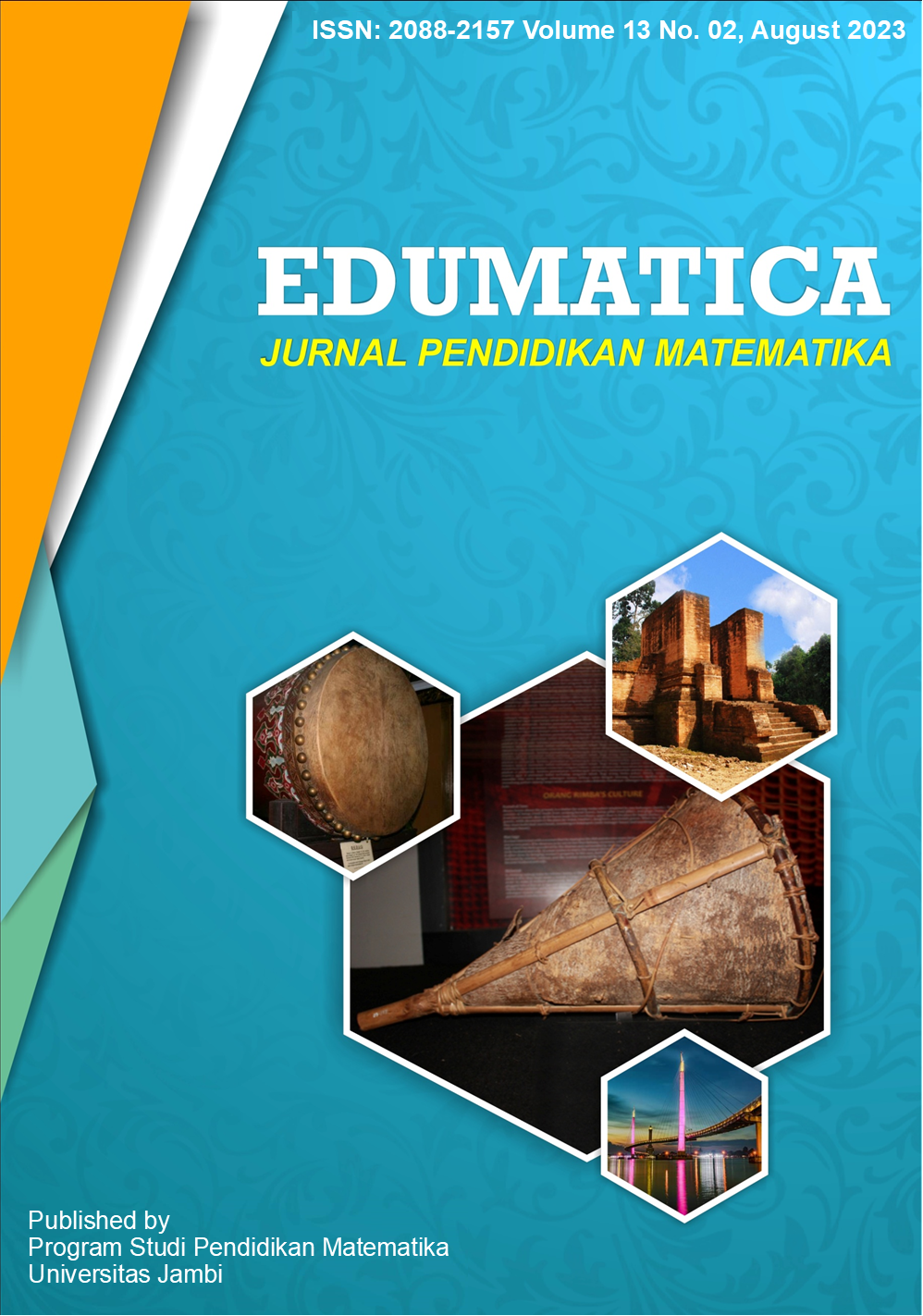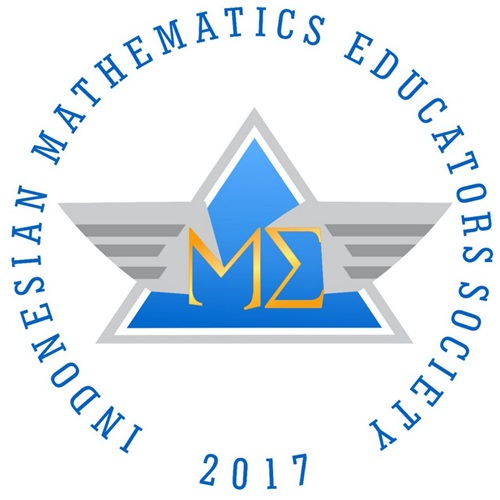The Effect of Using Electronic Student Worksheets in Mathematics Learning on the Reasoning Ability of 8th-Grade Junior High School Students
DOI:
https://doi.org/10.22437/edumatica.v13i02.26352Keywords:
electronic student worksheets, mathematical reasoning abilityAbstract
This study aims to see the effect of the use of Electronic Student Worksheets on the reasoning ability of 8th-grade junior high school students in mathematics learning. The type of research used is quantitative research with Quasi-Experimental methods. The population in this study is all grade VIII students for the 2022/2023 school year and sampling using the Cluster Random Sampling technique. The samples used were 2 homogeneous classes, namely class VIII-F as an experimental class and VIII-E as a control class with 26 students each. Data collection was conducted using a reasoning ability test instrument in the topic of polyhedra as a posttest, with the questions in the instrument being in the form of essay-type responses. The prerequisite tests for data analysis are normality tests with the Product-Moment pearson formula and homogeneity tests with the Cronbach Alpha formula, hypothesis tests using t-tests and continued with influence testing using effect size tests. The results showed that the reasoning ability of experimental class students was higher than students in the control class. The impact of using Electronic Student Worksheets on students' reasoning ability is moderate in mathematics learning.
Downloads
References
Afifah, A. (2017). Pengembangan Lembar Kerja Siswa (LKS) Materi Program Linier Bercirikan Problem Based Learning Untuk Membangun Kemampuan Penalaran Matematis. Jurnal Educazione: Jurnal Pendidikan, Pembelajaran Dan Bimbingan Dan Konseling, 5(1), 1-7. Retrieved from https://www.proquest.com/scholarly-journals/discerns-special-education-teachers-about-access/docview/2477168620/se-2?accountid=17260%0Ahttp://lenketjener.uit.no/?url_ver=Z39.88-2004&rft_val_fmt=info:ofi/fmt:kev:mtx:journal&genre=article&sid=ProQ:ProQ%3Aed
Amanda, L., Yanuar, F., & Devianto, D. (2019). Uji Validitas dan Reliabilitas Tingkat Partisipasi Politik Masyarakat Kota Padang. Jurnal Matematika UNAND, 8(1), 179. https://doi.org/10.25077/jmu.8.1.179-188.2019
Asdarina, O., & Ridha, M. (2020). Analisis Kemampuan Penalaran Matematis Siswa dalam Menyelesaikan Soal Setara PISA Konten Geometri. Numeracy, 7(2). https://doi.org/10.46244/numeracy.v7i2.1167
Ayal, C. S., Kesuma, Y. S., Sabandar, J., & Dahlan, J. A. (2016). The enhancement of mathematical reasoning ability of junior high school students by applying mind mapping strategy. Journal of Education and Practice, 7(25), 50-58.
Aziz, H. E., & Hidayati, N. (2020). Analisis kemampuan penalaran matematis siswa SMP pada materi aritmatika Sosial. Prosiding Sesiomadika, 2(1c).
Becker, K., & Park, K. (2011). Effects of integrative approaches among science , technology , engineering , and mathematics ( STEM ) subjects on students ‘ learning : A preliminary meta-analysis. Journal of STEM Education, 12(5), 23-38.
Bombang, V., Fayeldi, T., & Pranyata, Y. I. P. (2022). Pengembangan LKPD Elektronik Menggunakan Aplikasi Live Worksheet Materi Bangun Ruang Sisi Datar pada Siswa Kelas VIII SMPN 17 Malang. RAINSTEK: Jurnal Terapan Sains & Teknologi, 4(1), 27-41.
BSNP. (2006). Standar Isi Untuk Satuan Pendidikan Dasar dan Menengah: Standar Kompetensi dan Kompetensi Dasar SMA / MA (Standards of Content for Elementary and Secondary Education Unit: Standard of Competence and Basic Competence for High Schools and Madrasah Aliyah). Jakarta: Badan Standar Nasional Pendidikan.
Cronbach, L. J. (1951). Coefficient alpha and the internal structure of tests. Psychometrika, 16(3), 297-334. https://doi.org/10.1007/BF02310555
Guilford, J. P. (1956). Fundamental Statistics in Psychology and Education: 3d Ed. McGraw-Hill.
Gustiadi, A., Agustyaningrum, N., & Hanggara, Y. (2021). Analisis Kemampuan Penalaran Matematis Siswa Dalam Menyelesaikan Soal Materi Dimensi Tiga. Jurnal Absis: Jurnal Pendidikan Matematika Dan Matematika, 4(1), 337-348.
Hayati, H. S., Astuti, P., & Febrian, F. (2022). Electronic Student Worksheets Based on Rigorous Mathematical Thinking for Sequence and Series Materials in Senior High School. Jurnal Gantang, 7(2), 185-197. https://doi.org/10.31629/jg.v7i2.5331
Indriani, F. F., & Sakti, N. C. (2022). Pengembangan e-LKPD Berbasis Komik untuk Meningkatkan Kemampuan Berpikir Kritis Peserta Didik Kelas XI IPS SMA. Jurnal PTK Dan Pendidikan, 8(1). https://doi.org/10.18592/ptk.v8i1.6414
Izzah, N., Asrizal, A., & Festiyed, F. (2021). Meta analisis effect size pengaruh bahan ajar IPA dan fisika berbasis STEM terhadap hasil belajar siswa. Jurnal Pendidikan Fisika, 9(1), 114-130.
Munika, R. D., Marsitin, R., & Sesanti, N. R. (2021). E-LKPD Berbasis Problem Based Learning Disertai Kuis Interaktif Matematika untuk Meningkatkan Kemampuan Berpikir Kritis. Jurnal Tadris Matematika, 4(2), 201-214. https://doi.org/10.21274/jtm.2021.4.2.201-214
Nababan, S. A. (2020). Analisis Kemampuan Penalaran Matematis Siswa Melalui Model Problem Based Learning. Jurnal Genta Mulia, 11(1), 6-12.
Nurazhaar, H. I. (2019). Penerapan Lembar Kerja Siswa (LKS) Berbasis Realistic Mathematics Education (RME) Terhadap Kemampuan Penalaran Matematis Siswa. JURNAL PEKA, 2(2), 36-42. https://doi.org/10.37150/jp.v2i2.1112
OECD. (2019). PISA 2018 Results (Volume I). https://doi.org/https://doi.org/https://doi.org/10.1787/5f07c754-en
Sandu Siyoto, & Sodik, M. A. (2015). Dasar Metodologi Penelitian. Yogyakarta: Literasi Media Publishing.
Subekti, M. A. S., & Prahmana, R. C. I. (2021). Developing interactive electronic student worksheets through discovery learning and critical thinking skills during pandemic era. Mathematics Teaching-Research Journal, 13(2), 137-174.
Syafitri, R. A., & Tressyalina. (2020). The Importance of the Student Worksheets of Electronic (E-LKPD) Contextual Teaching and Learning (CTL) in Learning to Write Description Text during Pandemic COVID-19. Proceedings of the 3rd International Conference on Language, Literature, and Education (ICLLE 2020), 284-287. Paris, France: Atlantis Press. https://doi.org/10.2991/assehr.k.201109.048
Tariani, K., Suastra, I. W., & Astawan, I. G. (2022). Pengembangan E-LKPD IPA berbasis Catur Asrama Kelas V. PENDASI Jurnal Pendidikan Dasar Indonesia, 6(1), 94-104. https://doi.org/10.23887/jurnal_pendas.v6i1.563
Umaroh, U., Novaliyosi, N., & Setiani, Y. (2022). Pengembangan Lembar Kerja Peserta Didik Elektronik (E-LKPD) Berbasis Problem Based Learning (PBL) untuk Memfasilitasi Kemampuan Penalaran Peserta Didik pada Materi Lingkaran. Wilangan: Jurnal Inovasi Dan Riset Pendidikan Matematika, 3(1), 61-70.
Wijaya, N. O. P., & Hidayat, H. (2022). Development of e-LKPD Based on Real Problems in Theory Statistics Data Class VI SDN 101868 Sena Village. Widyagogik : Jurnal Pendidikan Dan Pembelajaran Sekolah Dasar, 10(1), 132-147. https://doi.org/10.21107/widyagogik.v10i1.16815
Wulansari, R. D., & Nuryadi. (2022). Efektivitas Penggunaan E-LKPD Berbasis Problem Based Learning untuk Meningkatkan Kemampuan Pemahaman Konsep Peserta Didik. Jurnal Pendidikan Dan Konseling, 4(4), 338-344. Retrieved from https://core.ac.uk/download/pdf/322599509.pdf
Downloads
Published
How to Cite
Issue
Section
License
Copyright (c) 2023 Safaqa Ahmar, Slamet Soro

This work is licensed under a Creative Commons Attribution-NonCommercial-ShareAlike 4.0 International License.







